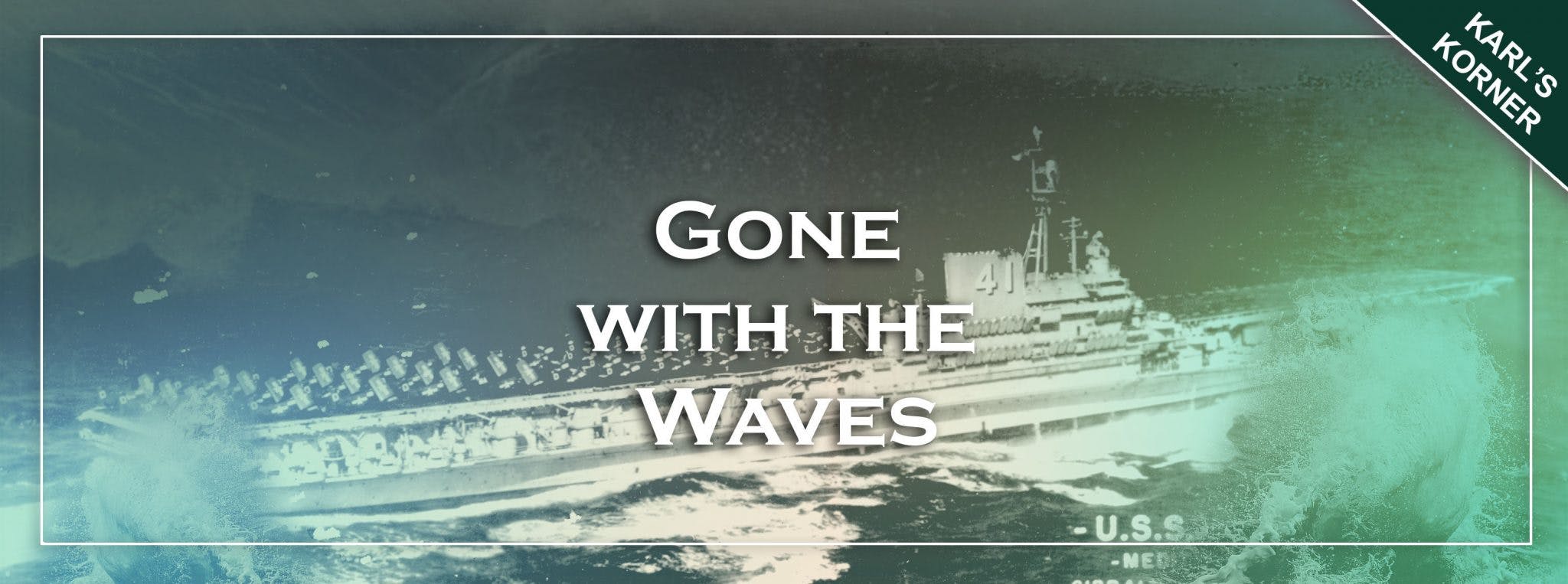 March 08, 2019 | Karl’s Korner
March 08, 2019 | Karl’s KornerGone With the Waves: Midway's Aircraft Elevator
Welcome back to Karl’s Korner, a historical segment written by myself, Karl Zingheim – Ship Historian of the USS Midway Museum. I recently shared about Midway's deck modifications in a previous post, click here if you missed my post about Midway's Extreme Angle. Today, I'm heading back to Midway circa 1955 to share a story about when the choppy seas made an unexpected modification to Midway Magic.
One Winter Day
The USS Midway underwent many design changes throughout her long career, one of the most significant occurring in the mid-1950s. After completing her round-the-world cruise into the Pacific in 1955, the Midway reported to the Bremerton Naval Shipyard for an extensive rebuilding and modernization. Among the improvements was a new aircraft elevator arrangement featuring a pair of deck edge platforms. One was sited at the end of the ship’s first angled deck, letting out on the Hangar Deck about where the Museum’s Cactus Collision display stands today. The other elevator was installed abaft the island superstructure, not far from where the present Elevator Number Two sits. These new elevators had a capacity for 65,000 pounds each, were all metal, and featured an elaborate lattice support system connected to deep trackways attached to the ship’s hull. Cable ways also supported the elevators from above. Although the deck edge arrangement improved the available flight deck space for spotting aircraft, the Midway’s comparatively low freeboard meant that the elevators worked well down the side of the ship, not all that far from the wave tops. Furthermore, since deployed carriers needed to perform underway replenishments frequently, the starboard elevator was often kept down at the hangar deck level to provide a platform for bringing supplied aboard and into the ship. On most days, this convention posed no problems and worked admirably to bring aboard bulky supplies. However, one wintry day off Japan in 1964, things did not work out so well. The seas were choppy, but the business of replenishing supplies still needed to go on, so the Midway steadied on base course and the stores ship pulled up alongside to starboard. Guidelines and hoisting gear were run out, and men lined up on the lowered elevator as well as inside the hangar deck to manhandle the incoming crates. Before long, however, the sea between the ships got into the action and waves began to lap up underneath the platform. Soon, a curler hit with enough force to heft the elevator upwards far enough to knock its guides out of alignment with the hull tracks. Worse, the wave was high enough to crest over the platform with enough energy to knock several men off their feet. Fortunately, no one was washed overboard, but the violence of the hit convinced everyone to scramble away into the hangar deck. Soon, an even larger wave struck, lifting the crooked elevator even higher, and then it dropped away, removing the platform completely away from its tracks. With the entire weight of the elevator momentarily supported by the cable tiers, in addition to the force of the structure’s movement, the cables snapped, causing the elevator to slice into the sea. The replenishment evolution was secured, and the elevator bays rolled shut. Though no one was lost in the incident, the practical matter of moving aircraft about with elevators available only amidships and well forward on the bow was complicated greatly. This situation was exacerbated by the arrival of the new carrier Kitty Hawk who challenged the mangled Midway to an air ops competition. The flight deck crew turned-to with a will, and the aircrews of Air Wing Two pressed on with their bombing and gunnery to wrest the victory from the neighboring Air Wing Eleven. On the afternoon of February 8th, Rear Admiral Thomas W. South, commanding Task Force 77, sent a flashing light message congratulating the Midway and her crew for winning the competition. “Kitty Hawk & CAW-11 are convinced that Midway and CAW-2 are resorting to all sorts of rivalry, skull duggery (sic), rule stretching, outright cheating, shifty tactics, etc.” The ship was still in mid-deployment, and no facilities in the region could replace the missing elevator, so the Midway carried on for three more months with the two remaining elevators. Finally, on 11 May 1964, she departed Subic Bay for a return to Alameda, and then across the Bay to Hunters Point shipyard where she was made whole again. The next deployment would be to Vietnam and combat. Thank you for reading and join me next time for the latest Karl's Korner! Leave me a comment below and let me know what other historic moments you'd like to learn more about!
Launch em’... until next time,
Karl
Your Adventure Starts Now
Your email is the key to information that will open up all your possibilities for exploring the mighty Midway!

